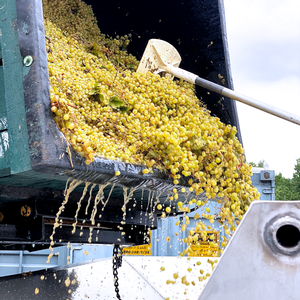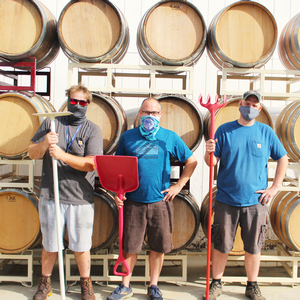It's Harvest Season! Learn How Your Favorite Wines Are Made!
 It's grape harvest season again and for the Adirondack Winery family, it's one of the most exciting times of the year.
It's grape harvest season again and for the Adirondack Winery family, it's one of the most exciting times of the year.
Over the next several weeks, we'll harvest over 160 tons of grapes (a new record!), trucked in from New York's famous Finger Lakes wine region. We don't have a vineyard here at Adirondack Winery, but we like it that way. This allows us to ship in the best grapes we can source from New York's best vineyards.
And while the wet summer has been a drag for the outdoorsy among us, it does have its benefits.
Our winemakers are anticipating a high-quality yield this year due to all of the rain, and it will start with the intake of Aurore grapes on Tuesday, Aug. 23rd. This grape is new to our lineup and is celebrated for its pale yellow color and distinct tangy finish.
Keep reading to learn more about how we transform grapes into your favorite wines during harvest season.
What Is Grape Harvest Season?
Grape harvest season is exactly what it sounds like. It’s the time of year when wineries harvest their grapes to begin the winemaking process. In the Northern Hemisphere, grape harvest season is August to October (and in the Southern Hemisphere, it’s February through April). It’s a range because of different climates within the hemisphere and because some grapes take longer times to ripen than others. For example, grapes used in sparkling wines are often harvested early in the season, when they have a higher acidity. White wine grapes are typically harvested before red wine grapes; the latter of which usually requires more time on the vine to mature.
For those interested in the science behind the ripening, grapes typically transform from hard little green berries to the green or purple grapes we know (and love) at about 30 to 70 days (depending on the climate). During this stage, the vines begin to impart sugar into the grapes, decreasing the acidity in the grape as time goes on. Sun and warmth can help hurry this process along.
At the Vineyard
A vineyard is a piece of land where grapes are grown. At each vineyard is a team that closely monitors the growth of the grapes and harvests them when they are ready. Winemakers look for a few telltale signs that signal when a grape is prepared to begin its journey from vine to glass. From a simple taste test (when they’re a real expert!) to gauging sugars, acidity and tannins (the part of the grape that create the drying sensation in your mouth when drinking wine), each winemaker has their own preferred process of determining when a grape is ready. Of course, Mother Nature also has her say, as it is common for winemakers to move harvesting grapes up or back due to heat, cold or rain.
Large scale vineyards typically harvest grapes with a machine that will remove the bunches from the vines or in some cases the vineyard staff will hand cut the grapes from the vine using shears. This often occurs super early in the day or even at night when it’s coolest. The grapes are collected into large bins (sometimes half-ton bins!) to be transported to their winery or to other wineries that buy the grapes from the vineyard. It is estimated that 2.5 pounds of grapes are needed to yield one bottle of wine.
 At the Winery
At the Winery
Contrary to popular belief, the winemaking process does not typically start with a group of wine elves stomping out piles of grapes.
But the grapes do need to be crushed and their stems removed.
Wineries typically use machines known as de-stemmers and crushers to get this done.
As we mentioned earlier, Adirondack Winery has its grapes shipped in from the Finger Lakes. This year we will receive 160 tons - or 320,000 pounds! And even though crushing and de-stemming the grapes is done by a machine, it still requires our team of winemakers and cellar helpers to work long days for several weeks in a row. The team is also responsible for separating the best grapes from the grapes considered unfit for winemaking.
The next steps vary based on which type of wine you are making, said Brad Casacci, Adirondack Winery's Winemaker.
“White wine grapes are pressed to have their juices collected immediately after they have been crushed,” Casacci said. “Red wines are fermented first (the process where yeast converts sugars to alcohol) then pressed and that extra contact with the grape skins is what gives red wine its red color.”
Wines can be aged anywhere from a few months to a few years and wines that have been aged longer are often held in more esteem.
We hope you’ll continue to follow our social media feeds to see our winemakers in action over the next several weeks – and we hope you enjoy this year’s yield more than any other before!
Click here to follow us on Facebook | Click here to follow us on Instagram
Ready to order some wine? Click here to save up to $15 on your wine order and get FREE shipping on 6+ bottles!
Cheers!